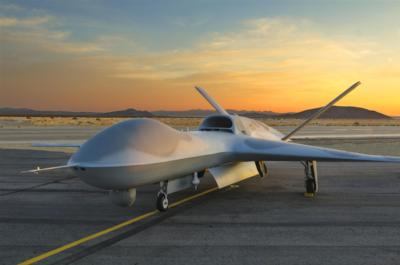Wed, Jan 18, 2023
New Learning Algos Allow Autonomous Thread Avoidance, Environmental Survey
General Atomics (GA-ASI) has continued its work integrating AI 'pilots' on the Open Mission System (OMS) software stack, announcing headway on flight-ready autonomous aircraft in multi-objective testing.

The company advanced its Collaborative Combat Aircraft (CCA) ecosystem with a battery of test missions with artificially intelligent (AI) pilots, evaluating their ability to undergo collaborative combat missions. The flights took place at General Atomics' Desert Horizons flight operations facility in El Mirage, California. In it, a company-owned Avenger UAV was paired with “digital twin” aircraft to autonomously conduct Live, Virtual, and Constructive (LVC) multi-objective collaborative combat missions, putting the digital wingmen through their paces as hands-off combat assets. Throughout the flights, General Atomics sought to enhance the capabilities of its AI systems to "make decisions under dynamic and uncertain
real-world conditions".
As is always the case in software, however, it's much easier said than done. The company's novel Reinforcement Learning (RL) architecture leans heavily on the software industry's ever-present "agile methodology" and a suite of industry tools like Docker and Kubernetes to develop an operationally relevant learning algorithm. So far, their Reinforcement Learning software has demonstrated a few promising behaviors, being able to fly both a live and virtual Avenger simultaneously.

While doing so, a single RL agent was able to chase a target while avoiding threats. A hierarchical RL agent was able to collate sensor data and select appropriate courses of action while in flight, demonstrating the "AI pilot"'s ability to act on real-time information without human input. While performance has largely been suitable to basic threat avoidance and route mapping, General Atomics expects to see compounding benefits as additional AI pilot data is fed into their 'rapid retaining process' for analysis and reuse.
“The concepts demonstrated by these flights set the standard for operationally relevant mission systems capabilities on CCA platforms,” said GA-ASI Senior Director of Advanced Programs Michael Atwood. “The combination of airborne high-performance computing, sensor fusion, human-machine teaming, and AI pilots making decisions at the speed of relevance shows how quickly GA-ASI’s capabilities are maturing as we move to operationalize autonomy for CCAs.”
More News
Circle To Runway (Runway Number) Used by ATC to inform the pilot that he/she must circle to land because the runway in use is other than the runway aligned with the instrument appr>[...]
Aero Linx: National Aviation Safety Foundation (NASF) The National Aviation Safety Foundation is a support group whose objective is to enhance aviation safety through educational p>[...]
At Altitude Of About 250-300 Ft Agl, The Airplane Experienced A Total Loss Of Engine Power On November 6, 2024, at 1600 central standard time, a De Havilland DHC-1, N420TD, was inv>[...]
From 2009 (YouTube Edition): Three Hour Flight Was 'Flawless' -- At Least, Until Mother Nature Intervened For anyone who loves the aviation business, this was a VERY good day. Afte>[...]
Also: AMA Names Tyler Dobbs, More Falcon 9 Ops, Firefly Launch Unsuccessful, Autonomous F-16s The Air Force has begun ground testing a future uncrewed jet design in a milestone tow>[...]
 ANN's Daily Aero-Term (05.05.25): Circle To Runway (Runway Number)
ANN's Daily Aero-Term (05.05.25): Circle To Runway (Runway Number) ANN's Daily Aero-Linx (05.05.25)
ANN's Daily Aero-Linx (05.05.25) NTSB Prelim: De Havilland DHC-1
NTSB Prelim: De Havilland DHC-1 Classic Aero-TV: The Boeing Dreamliner -- Historic First Flight Coverage
Classic Aero-TV: The Boeing Dreamliner -- Historic First Flight Coverage Airborne-NextGen 05.06.25: AF Uncrewed Fighters, Drones v Planes, Joby Crew Test
Airborne-NextGen 05.06.25: AF Uncrewed Fighters, Drones v Planes, Joby Crew Test




